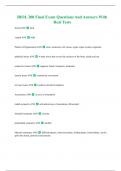BIOL 200 Final Exam Questions And Answers With
Real Tests
dorsal ANS back
ventral ANS belly
Pattern of Organization ANS atom, molecule, cell, tissue, organ, organ system, organism
epithelial tissue ANS A body tissue that covers the surfaces of the body, inside and out
connective tissue ANS supports, binds, transports, immunity
muscle tissue ANS contraction, movement
nervous tissue ANS conducts electrical impulses
Asymmetry ANS no axis of orientation
radial symmetry ANS oral-aboral axis of orientation, (flowerpot)
briradial symmetry ANS circular
pentaradial symmetry ANS starfish
bilateral symmetry ANS different planes, transverse plane, median plane, frontal plane. can be
split into dorsal, posterior and anterior.
,unicellular ANS single cell or cellular aggregates, not alot of cellular specialization, protists
diploblastic organization ANS cells organized into rudimentary tissues, two embryonic cell
layers, ectoderm and endoderm and mesoglea
triploblastic organization ANS 3 layers, ectoderm, endoderm, mesoderm. there is a coelom,
which is a body cavity surrounded by mesoderm, 3 different patterns- acoelomte animals,
pseudocoelomate animals, and coelomate animals.
protostomes (triploblastic) ANS spiral cleavage, blastopores develop into mouth, schizocoelous
coelom, trochophore larva
Deuterostomes (triploblastic) ANS radial cleavage, blastopore develops into anus, entercoelous
coelom, no trochophore larva
Protist Evolution ANS all groups presented by cambrian period and are polyphyletic
four supergroups contain animal like forms, some species are animal like and plant like.
animal like protist ANS unicellular, have a pellicle composed of microtubules.
asexual reproduction for protists ANS binary fission (can split in different ways)
schizogony (mitotic division)
budding (can come off of a cell, some generative atomical point of the parent)
sexual reproduction in protists ANS variation amoung taxa
gametes are produced by haploid individuals
mesiosis shortly after zygotic meiosis
sex unknown in some forms (Amoebozoa)
supergroup excavata ANS excavated groove on one side of the cell body for feeding,
, phytoflagated/ zooflagellated
modified mitochondria and are anaerobic (with oxygen)
can be pathogenic to humans
Giardia intestinalis (Excavata) ANS beaver fever, very common in water born disease
infects small intestine- diarrhel disease
trichomonas vaginalis (excavata) ANS common STD, men are usually asymptomatic
super group amoebozoa ANS feed and move using pseudopodia (a temporary protrusion)
with and without supporting structures
tests, calcareous, proteinaceous, siliceous, chitinous, secreted matrix, uses phagocytosis
acanthamoebida spp. Amoebozoa ANS Naegleria flowering- keratitis
acanthamoeba spp.- encephalitis
Entamoeba histolytica (Ameobozoa) ANS lacks mitochondria
amoebic dysentery
super group rhizaria ANS amoeboid, but not sister group to amoebozoa
some have flipped filopodia or axopodia (little pieces that come off of the cell)
foraminifera (rhizaria) ANS marine
calacarous test
many in fossil record
limestone and chalk deposits
super group alveolata ANS highly variable




